SEO
The 9 Best Keyword Research Tools
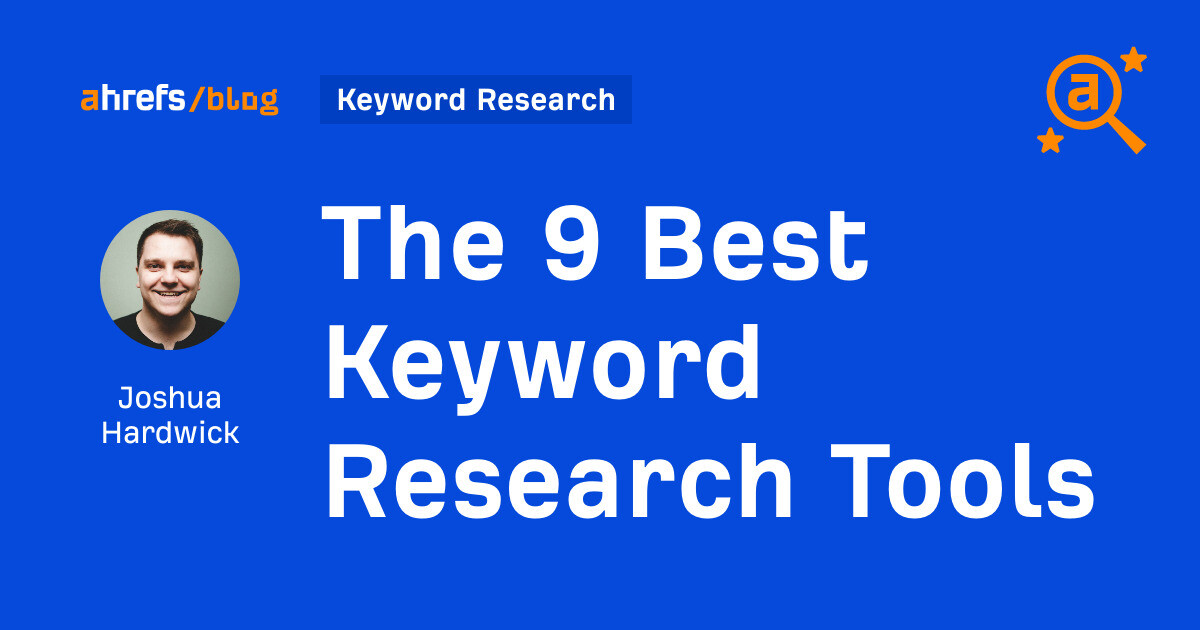
Keyword research is a three-step process:
- Find keyword ideas that people are searching for
- Check their ranking difficulty
- Figure out the best way to rank
In this post, you’ll learn how to do these tasks with nine free keyword research tools.
The best free keyword research tools
Keyword Generator shows up to 150 keyword ideas. Just enter a broad topic, choose your target country, and hit “Find keywords.”

For example, search for “bitcoin,” and you’ll see the 100 most popular keywords containing that word from our database of over 19 billion keywords:

You also see a list of the 50 most popular questions people are searching for:

Each list also has a Keyword Difficulty (KD) score for the first 10 keywords. The closer this is to 100, the harder it’ll be to rank for the keyword (more on this in point #9).
Keyword ideas too broad? Feed them back into the generator
Let’s say you enter “bitcoin,” and the generator kicks back “bitcoin mining.” If you want to explore that topic further, feed it back into the generator. If you want to go even narrower, do another round.
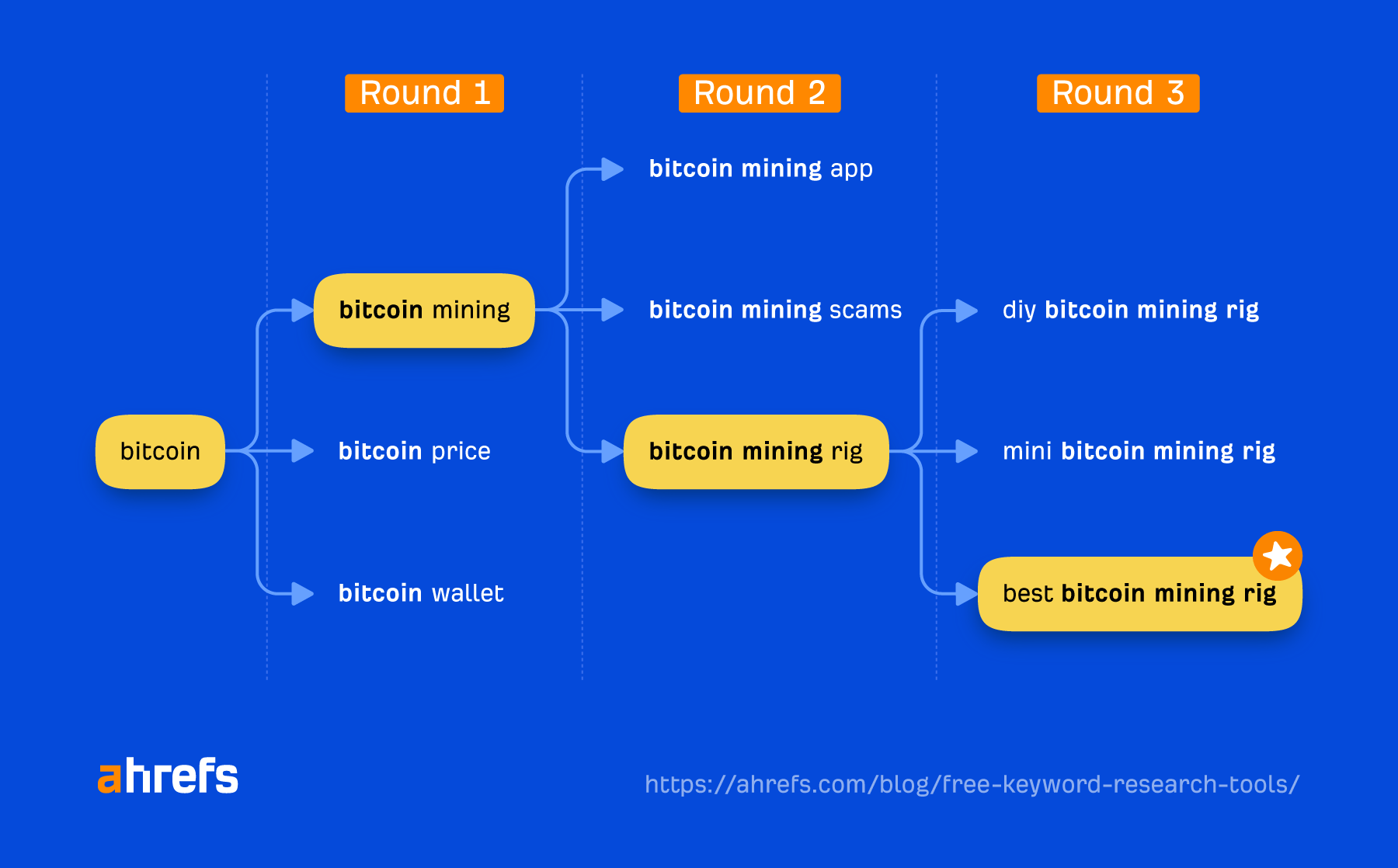
Answer The Public uses autocomplete to find questions people are searching for. Just enter a broad topic, choose your target country, and hit “search.”
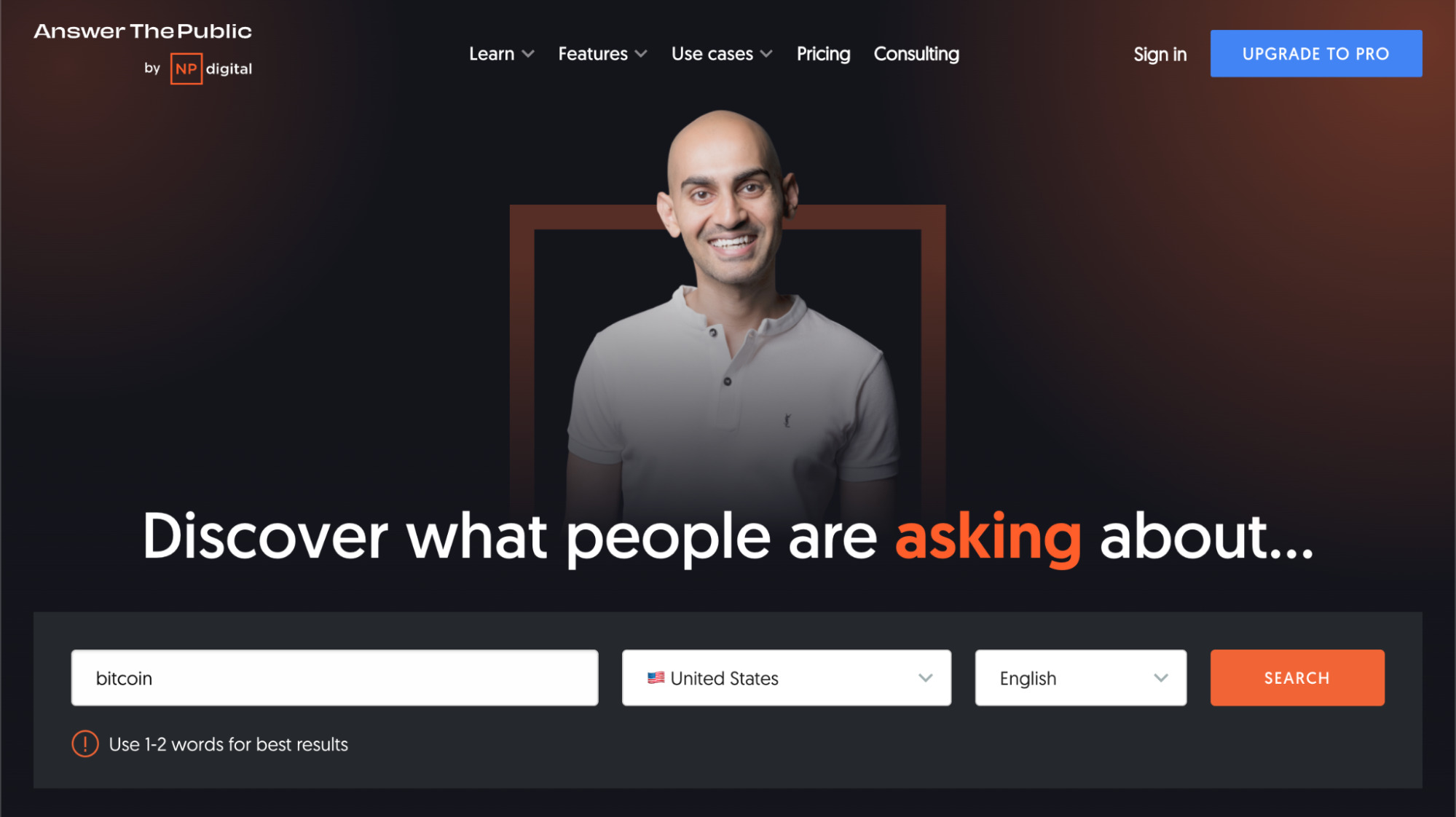
For example, search for “bitcoin” and you’ll see 392 keyword ideas split into five categories:
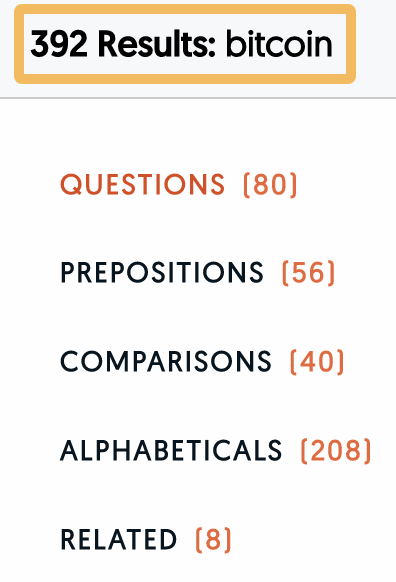
Each category (except for alphabeticals) visualizes the keyword ideas like this:

Unfortunately, it doesn’t show keyword search volumes. However, the red circles next to each keyword (supposedly) tell you whether it gets a high, average, or low number of monthly searches.

Looking for actual search volumes?
Paste keyword ideas from Answer The Public into Ahrefs’ free keyword generator. The first keyword on the list will usually be the one you entered, and you’ll see its search volume.

ChatGPT is a chatbot from OpenAI. It’s not very useful for keyword research as a whole, but it is useful for finding seed keyword ideas.
For example, if you ask for a list of terms related to bitcoin, here’s what it comes up with:

Not all these are good seed keywords because they’re too generic and have multiple meanings (e.g., “fork”), but some are.
For example, suppose you plug a not-so-obvious seed like “hashrate” into our free keyword generator. In this case, it looks like many people are searching for the hashrates of different mining hardware:
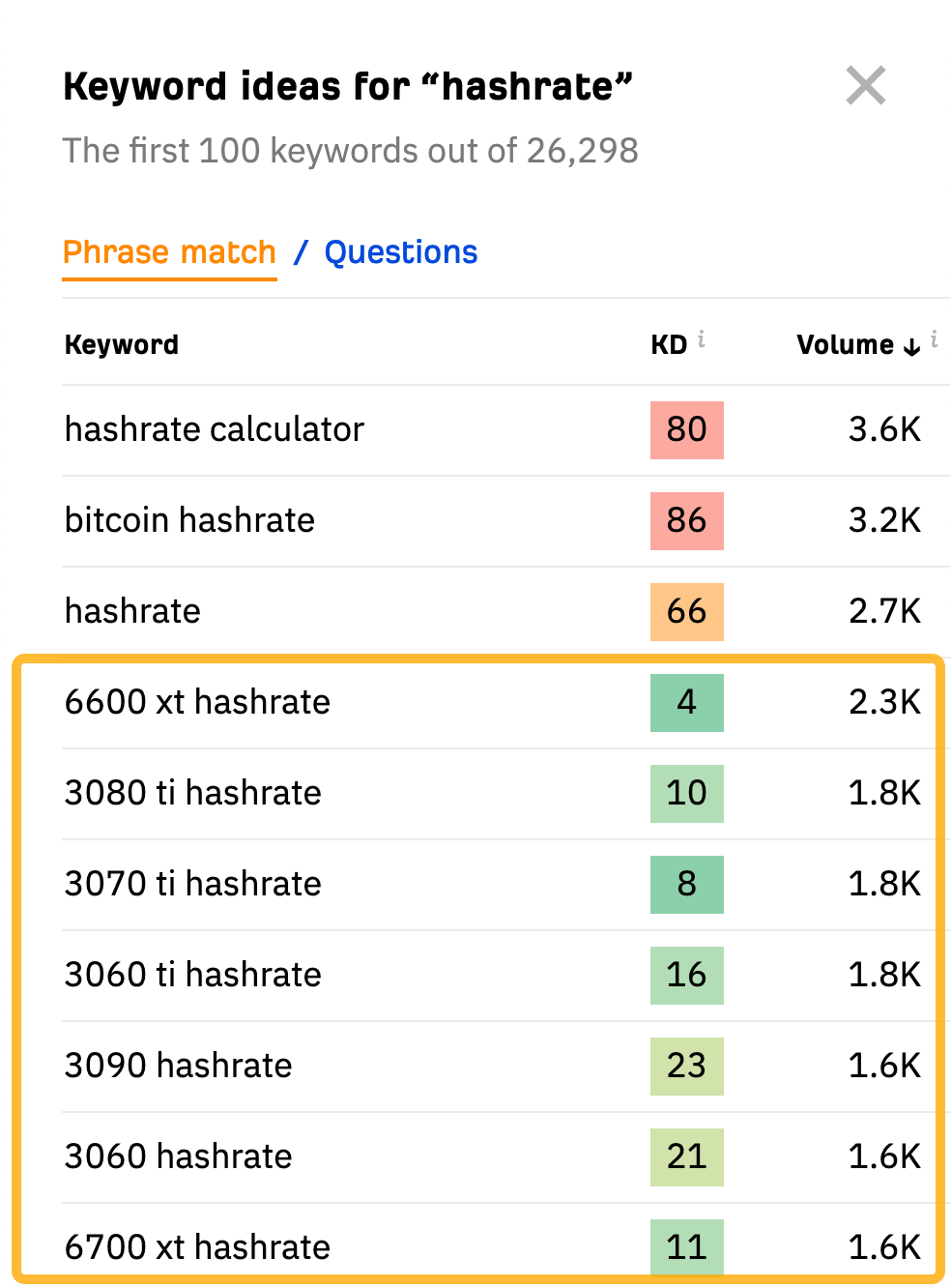
Unless you know the crypto industry inside out, you probably wouldn’t have thought of this seed keyword or discovered these keyword ideas.
Getting underwhelming results from your ChatGPT prompts?
Don’t ask for keyword ideas. Ask for terms related to a topic by starting your prompt with “give me a list of terms related to…”

Ahrefs Webmaster Tools shows all the keywords you currently rank for in the top 100. Just go to the Organic keywords report in Site Explorer.

There are many ways to use this report for keyword research, but one of my favorites is to find low-hanging page two rankings. To do this, filter for keywords in positions 11-20 and toggle the “Main positions only” switch.
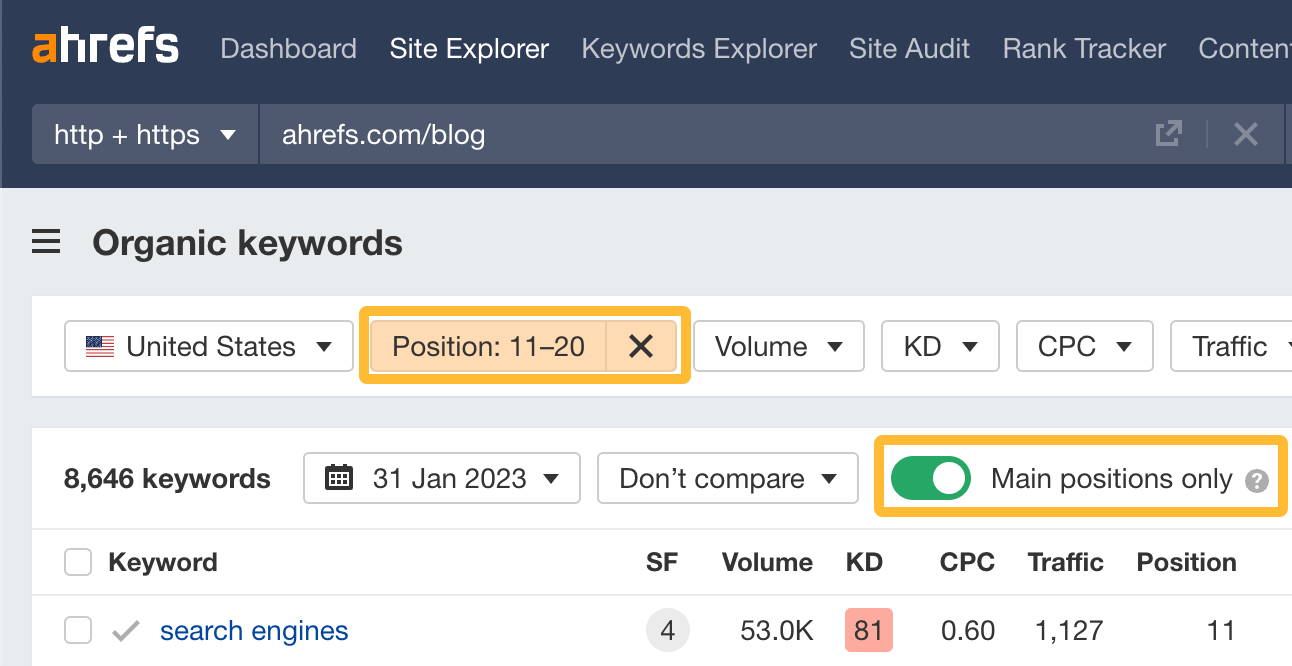
As hardly anyone clicks on page two results, boosting your rankings for these keywords by just a few positions to page one can often massively boost traffic.
For example, we rank in position 11 for “pagerank”:

By applying our SEO checklist to this post or refreshing and republishing the content, we could likely hit the first page for this keyword and get way more traffic.
Not sure which keywords to prioritize?
If you have thousands of page two rankings, prioritize keywords with the highest “business potential.”

Google Keyword Planner is a keyword research tool for advertisers. But you can also use it to find keywords for SEO. It’s particularly useful for finding related keywords that don’t contain your seed keyword.
For example, search for “crypto,” and it kicks back ideas like “altcoin” and “safemoon coin”:

In fact, of the 880 keyword ideas found by Keyword Planner, 735 don’t contain the seed keyword “cryptocurrency.”
Unfortunately, Keyword Planner only gives search volume ranges instead of exact volumes (unless you’re running search ads). But you can always copy and paste ideas into Ahrefs’ free keyword generator for a more accurate estimate.
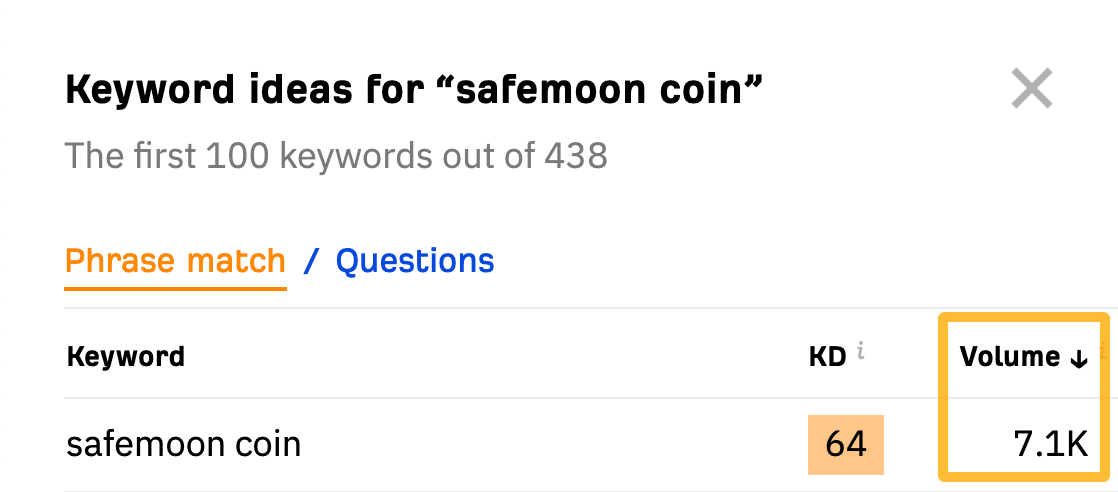
Looking for even more related keywords?
Instead of starting with a seed keyword, start with a seed website.
For example, suppose you use bitcoin.org as the seed site. In that case, you get some hyper-specific keyword ideas that you might easily overlook in “conventional” keyword research tools.
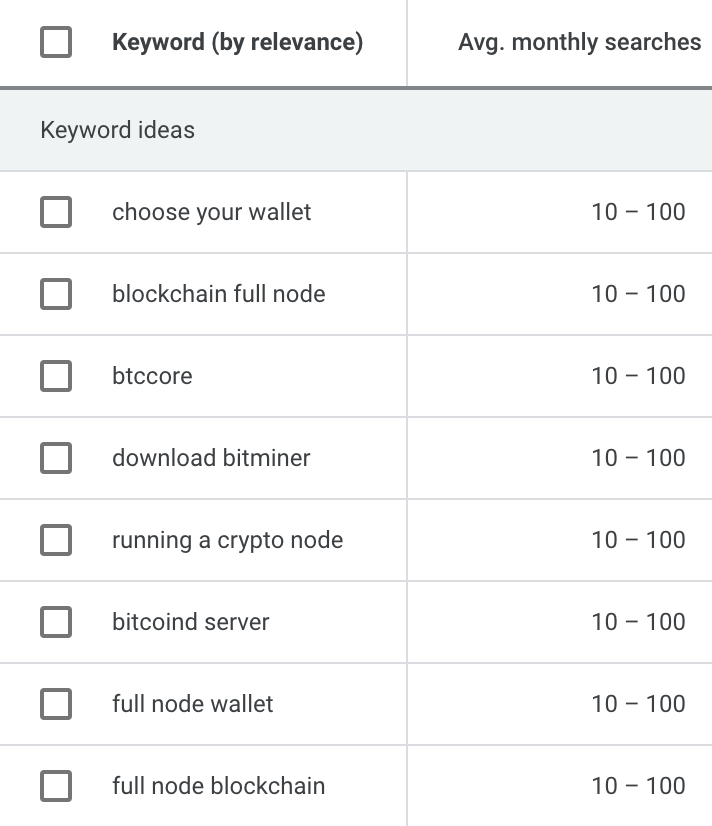
Google Search Console (GSC) shows how your website performs for its top 1,000 keywords in organic search. Just go to the Search results report.

There are many ways to use this report for keyword research, but one way is to find declining keywords that need your attention.
For example, if we compare the last three months’ performance for the Ahrefs Blog to the same period last year and sort the table by “Clicks Difference” from high to low, we can see that we’ve lost the most clicks from the query “google keyword planner”:
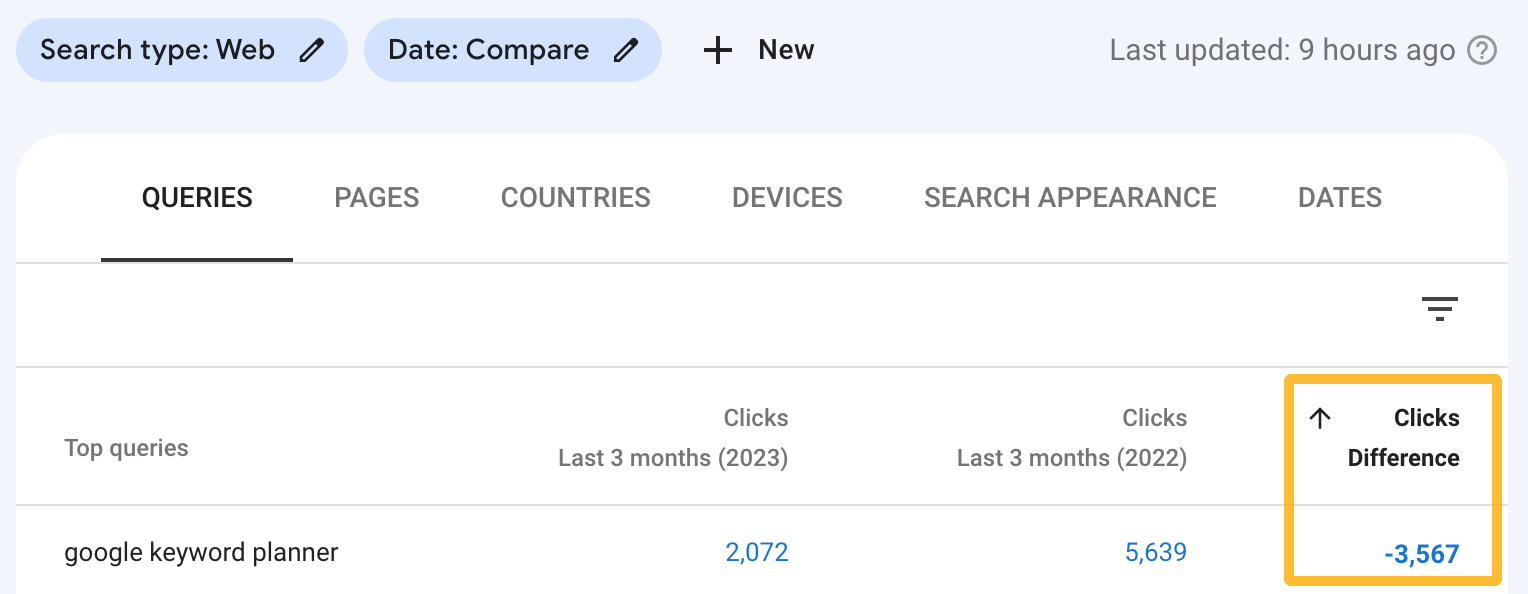
To try to fix this, we recently updated and republished our guide to Google Keyword Planner—and it worked.
Here are the clicks from that keyword for the past two months:
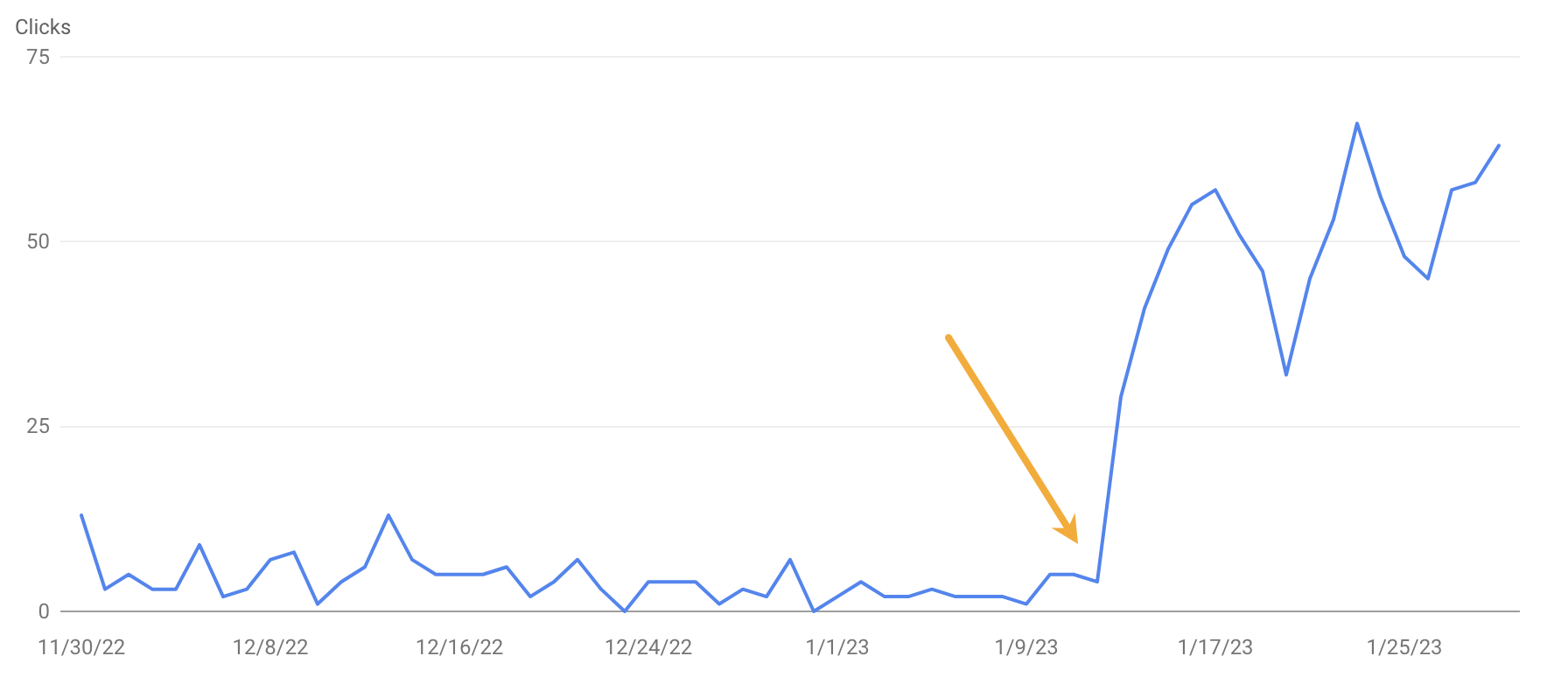
This shows how there’s sometimes more to gain from retargeting old keywords than going after new ones.
Don’t make the mistake of ignoring seasonality
Make sure to choose a year-over-year comparison period in GSC. Otherwise, you risk seeing skewed numbers due to seasonality.
For example, our traffic always dips in December when people are off enjoying the holiday season. If we were to compare the first and last six months of the year, the numbers would be skewed and might lead us astray.
Google Trends visualizes the relative search popularity of a keyword over time. It also shows related rising and breakout searches. This is useful for finding trending keywords.
For example, search for “ai content,” and you will see a massive spike in interest recently:
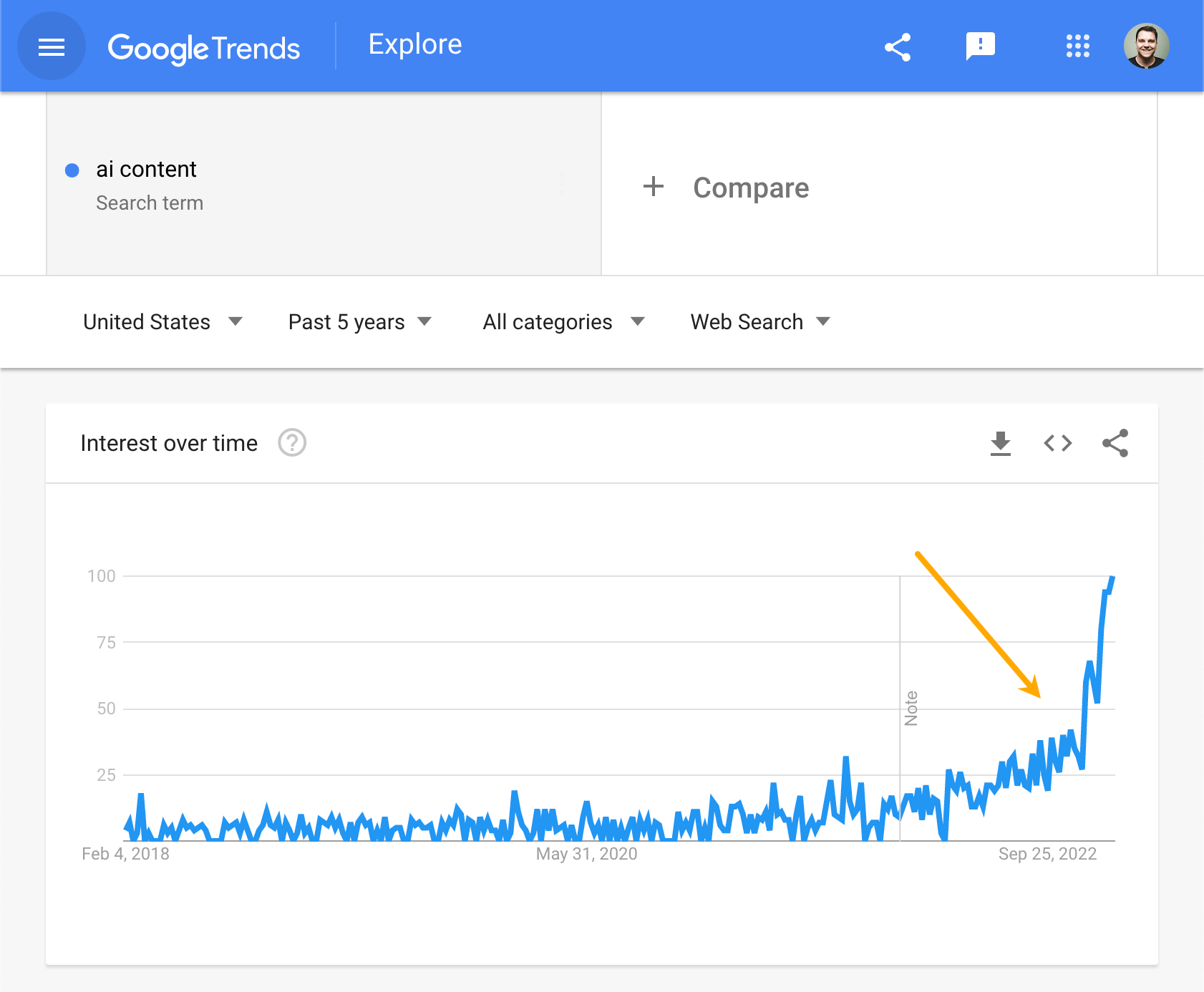
If you then scroll down to the “Related queries” section, you’ll see rising and breakout keywords like “ai content creator,” “open ai,” and “chatgpt”:

There’s often a delay before trending keywords like these appear in traditional keyword research tools, making Google Trends a neat way to find newly popular topics before your competitors.
Looking for specific ideas related to trending topics?
Just plug a rising topic back into Google Trends.
For example, if you put “chatgpt” (a rising topic from our search) into Google Trends, you see more specific things people are searching for around that topic.
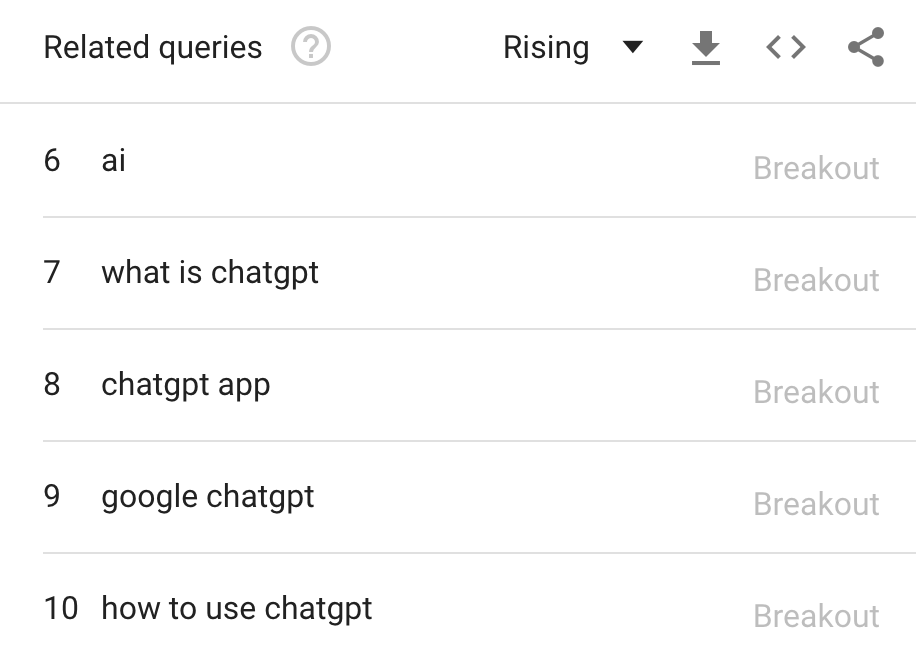
SERP Checker shows the top-ranking pages for (almost) any keyword, plus useful SEO metrics for the top three pages. It’s particularly useful for understanding a keyword’s traffic potential.
For example, Keyword Generator shows that “best bitcoin mining rig” has an average monthly search volume of 500 in the U.S.:

But if you plug this keyword into SERP Checker, you see that the top three search results get between 1K and 1.8K estimated monthly search visits. That’s 2-4X more than the keyword’s search volume.
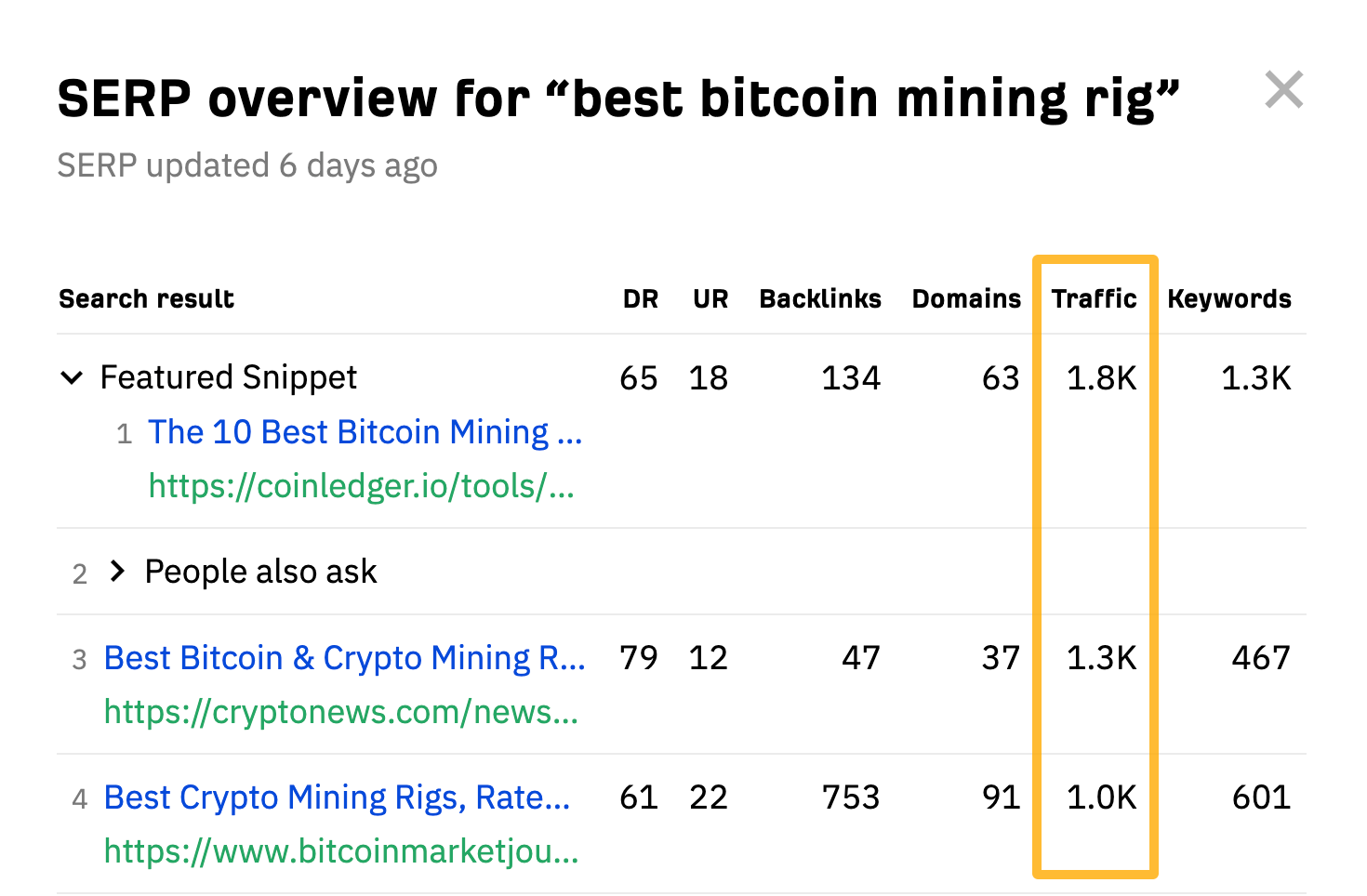
This happens because pages tend to rank for (and get traffic from) many keywords, not just one.
Because of this, the estimated search traffic to the top-ranking pages is usually a better proxy of a keyword’s true traffic potential than search volume. So it’s worth plugging promising keyword ideas into SERP Checker to better understand how much traffic you can get by ranking.
Do top-ranking pages get less traffic than the keyword’s search volume?
Traffic potential isn’t always higher than a keyword’s search volume. Sometimes, it’s lower.
For example, “how many people own bitcoin” gets an estimated 1.4K monthly searches in the U.S., but SERP Checker shows that the top-rankings get significantly less traffic than this—despite ranking for hundreds of keywords:
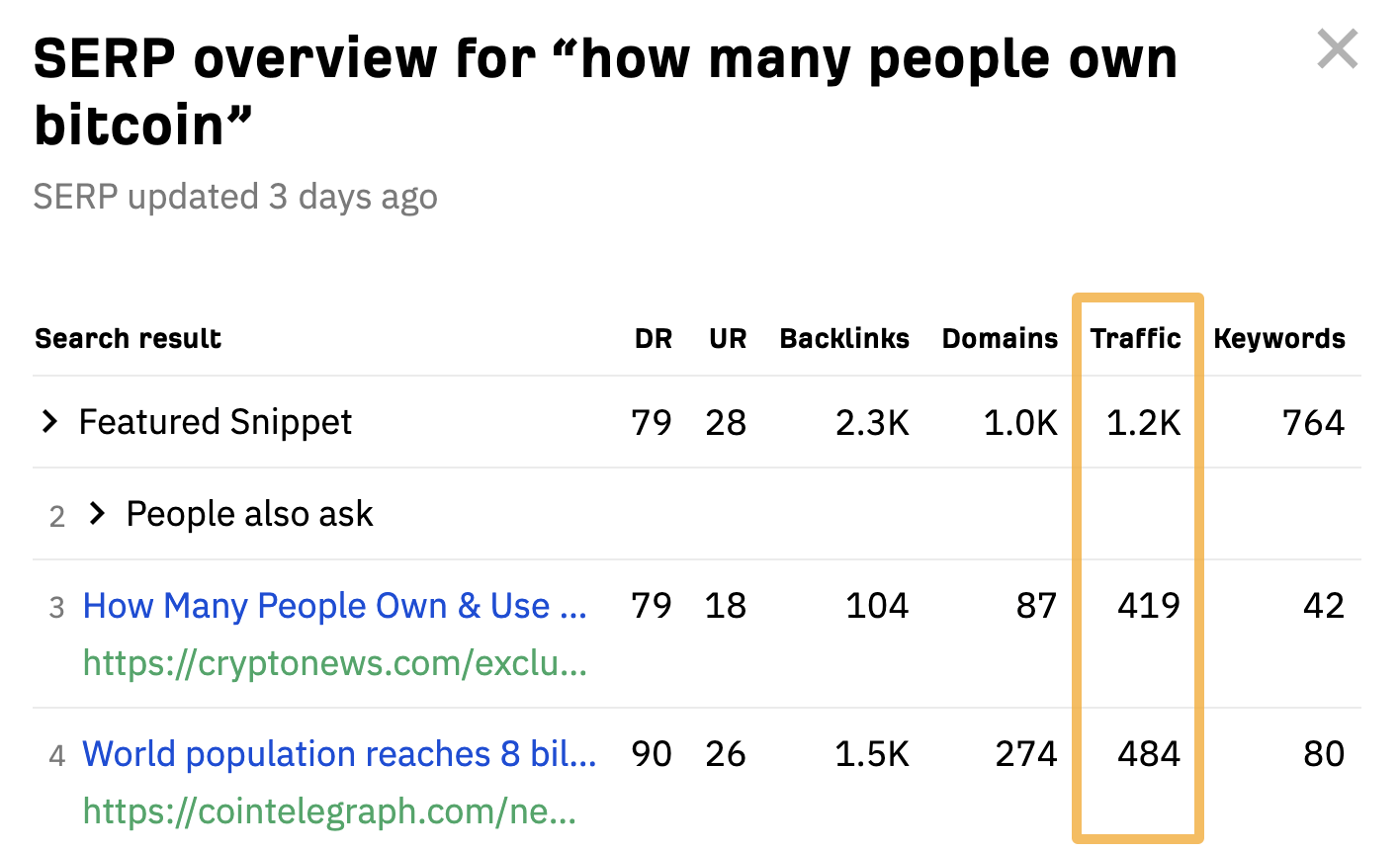
There are many reasons this can happen. In this case, it’s probably because Google answers the question on the SERP, so most searchers don’t need to click a result.
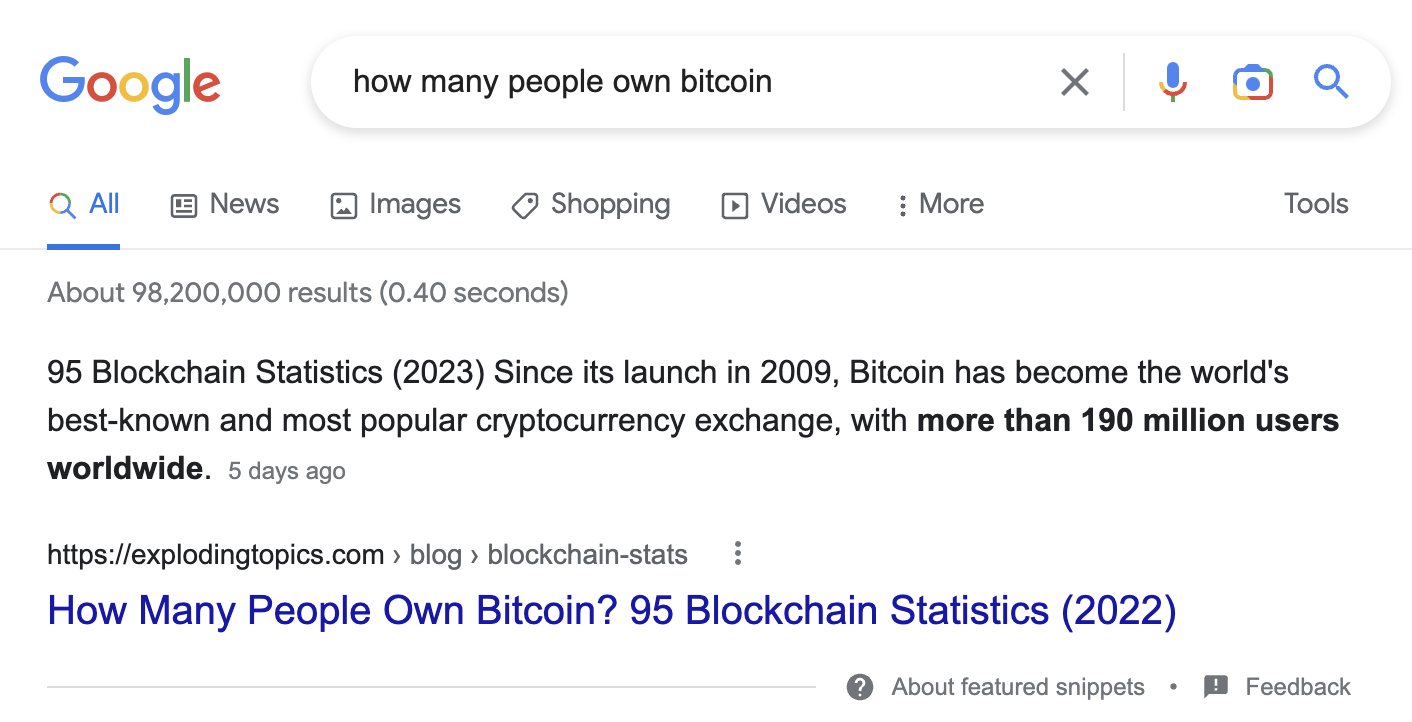
Keyword Difficulty (KD) Checker estimates how hard it will be to rank in the top 10.
For example, the KD score for “bitcoin” is 99/100, meaning it’s super hard to rank for:

Yet the KD score for “litecoin vs bitcoin” is only 9/100, so it should be quite easy to rank for:
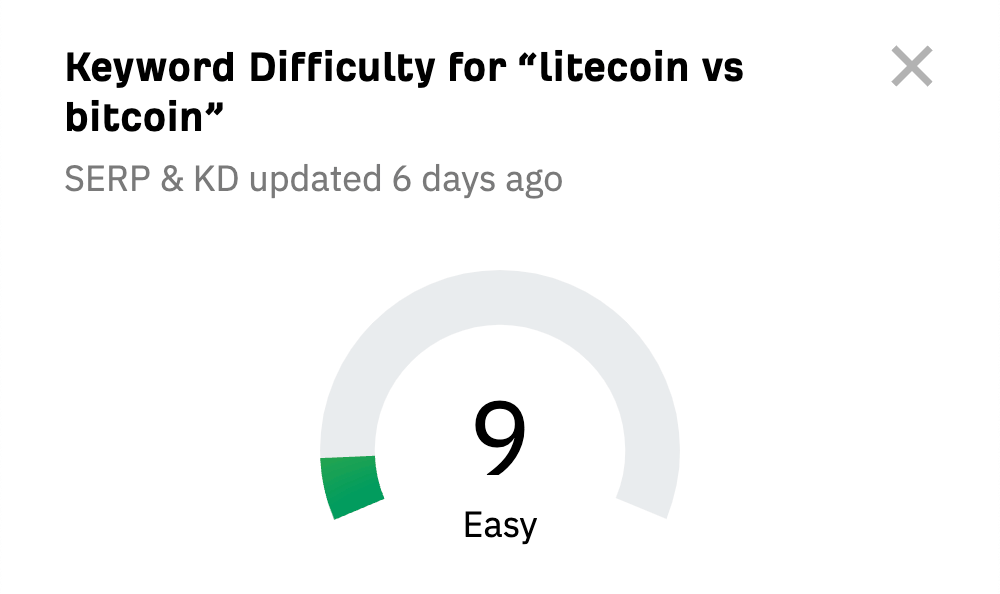
That said, KD is based solely on backlinks. It doesn’t consider anything else that may affect ranking difficulty, such as content quality.
Because of this, a high KD score just means you’ll likely need lots of backlinks to compete. You should always investigate ranking difficulty further before going after a keyword.
Looking for a rough estimate of how many backlinks you need?
Check the estimate below the Keyword Difficulty (KD) score.
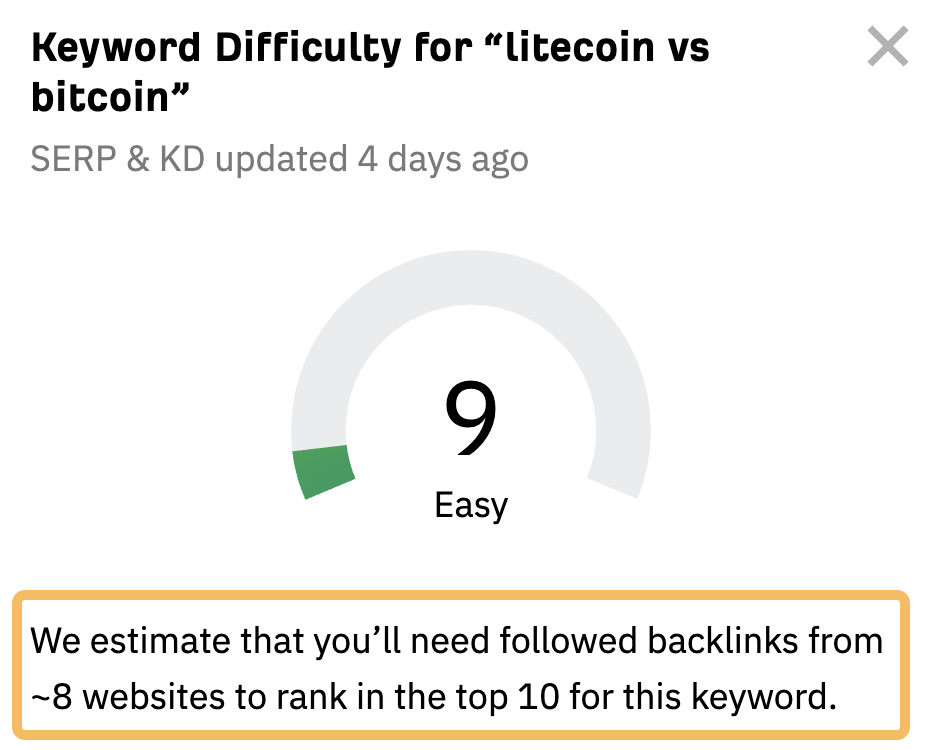
Free vs. paid keyword tools: how do they compare?
Free keyword research tools are super useful when you’re just starting out. Still, the number of keyword ideas and data they show will always pale compared to paid tools.
For example, search for “bitcoin” in our free keyword generator, and you’ll get 150 keyword ideas. But if you search for the same seed in our paid keyword research tool, Keywords Explorer, and go to the Matching terms report, you get 763,256 keyword ideas:

Plus, there are a bunch of filters to help you find the best ideas for your website.
For example, if you have a new website, you might want to find low-difficulty keywords with good search volume and traffic potential. You can do this in seconds by applying Keyword Difficulty (KD), volume, and Traffic Potential (TP) filters.
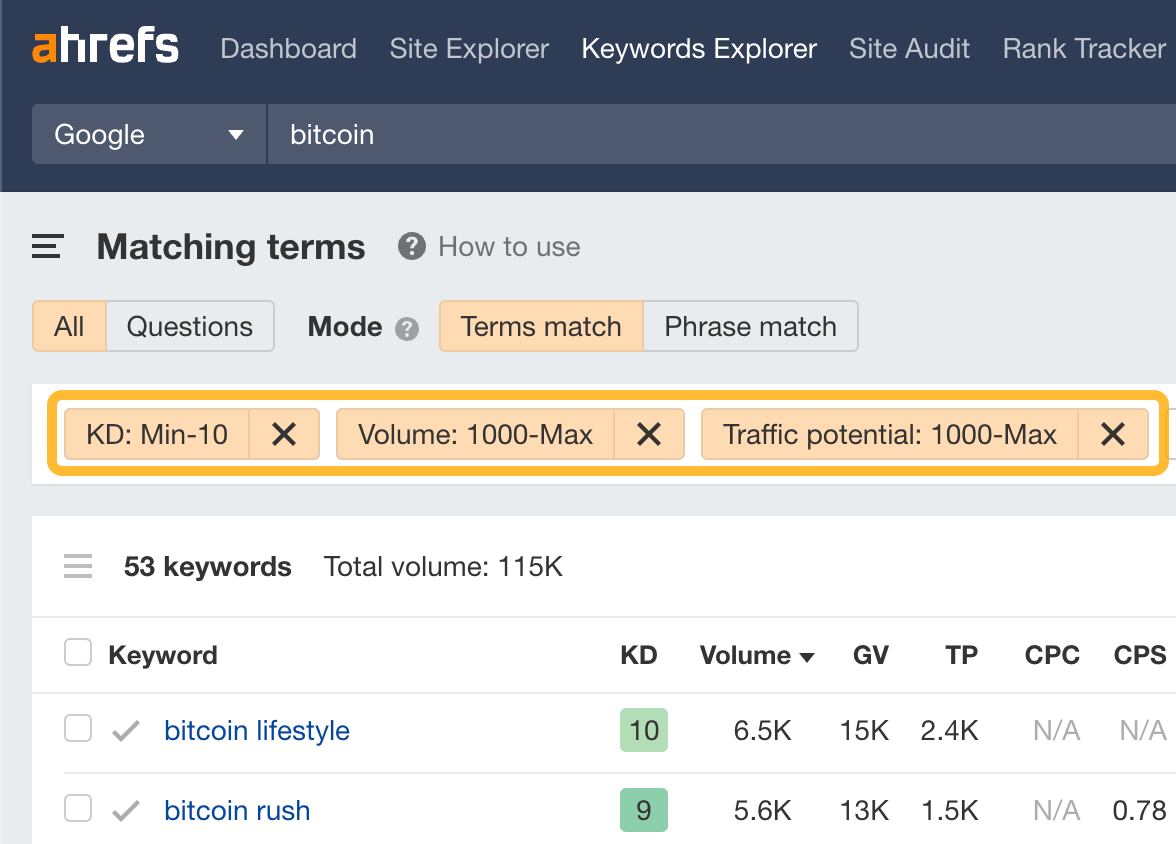
From there, you can easily check the top-ranking pages to assess the competition. Just click the “SERP” dropdown or click the keyword and scroll to the SERP overview:

Final thoughts
If you’re new to SEO, free keyword research tools will be enough to discover some good keyword ideas for your website. But once your website grows and the value of your time skyrockets, paid keyword research tools are worth every penny.
This is because paid keyword tools give you more data and allow for more efficient workflows, so you can find better keyword ideas in less time.
Looking to learn more about keyword research? Read our beginner’s guide to keyword research or watch this video:
Did I miss any good free keyword research tools? Ping me on Twitter.
SEO
Google Cautions On Blocking GoogleOther Bot

Google’s Gary Illyes answered a question about the non-search features that the GoogleOther crawler supports, then added a caution about the consequences of blocking GoogleOther.
What Is GoogleOther?
GoogleOther is a generic crawler created by Google for the various purposes that fall outside of those of bots that specialize for Search, Ads, Video, Images, News, Desktop and Mobile. It can be used by internal teams at Google for research and development in relation to various products.
The official description of GoogleOther is:
“GoogleOther is the generic crawler that may be used by various product teams for fetching publicly accessible content from sites. For example, it may be used for one-off crawls for internal research and development.”
Something that may be surprising is that there are actually three kinds of GoogleOther crawlers.
Three Kinds Of GoogleOther Crawlers
- GoogleOther
Generic crawler for public URLs - GoogleOther-Image
Optimized to crawl public image URLs - GoogleOther-Video
Optimized to crawl public video URLs
All three GoogleOther crawlers can be used for research and development purposes. That’s just one purpose that Google publicly acknowledges that all three versions of GoogleOther could be used for.
What Non-Search Features Does GoogleOther Support?
Google doesn’t say what specific non-search features GoogleOther supports, probably because it doesn’t really “support” a specific feature. It exists for research and development crawling which could be in support of a new product or an improvement in a current product, it’s a highly open and generic purpose.
This is the question asked that Gary narrated:
“What non-search features does GoogleOther crawling support?”
Gary Illyes answered:
“This is a very topical question, and I think it is a very good question. Besides what’s in the public I don’t have more to share.
GoogleOther is the generic crawler that may be used by various product teams for fetching publicly accessible content from sites. For example, it may be used for one-off crawls for internal research and development.
Historically Googlebot was used for this, but that kind of makes things murky and less transparent, so we launched GoogleOther so you have better controls over what your site is crawled for.
That said GoogleOther is not tied to a single product, so opting out of GoogleOther crawling might affect a wide range of things across the Google universe; alas, not Search, search is only Googlebot.”
It Might Affect A Wide Range Of Things
Gary is clear that blocking GoogleOther wouldn’t have an affect on Google Search because Googlebot is the crawler used for indexing content. So if blocking any of the three versions of GoogleOther is something a site owner wants to do, then it should be okay to do that without a negative effect on search rankings.
But Gary also cautioned about the outcome that blocking GoogleOther, saying that it would have an effect on other products and services across Google. He didn’t state which other products it could affect nor did he elaborate on the pros or cons of blocking GoogleOther.
Pros And Cons Of Blocking GoogleOther
Whether or not to block GoogleOther doesn’t necessarily have a straightforward answer. There are several considerations to whether doing that makes sense.
Pros
Inclusion in research for a future Google product that’s related to search (maps, shopping, images, a new feature in search) could be useful. It might be helpful to have a site included in that kind of research because it might be used for testing something good for a site and be one of the few sites chosen to test a feature that could increase earnings for a site.
Another consideration is that blocking GoogleOther to save on server resources is not necessarily a valid reason because GoogleOther doesn’t seem to crawl so often that it makes a noticeable impact.
If blocking Google from using site content for AI is a concern then blocking GoogleOther will have no impact on that at all. GoogleOther has nothing to do with crawling for Google Gemini apps or Vertex AI, including any future products that will be used for training associated language models. The bot for that specific use case is Google-Extended.
Cons
On the other hand it might not be helpful to allow GoogleOther if it’s being used to test something related to fighting spam and there’s something the site has to hide.
It’s possible that a site owner might not want to participate if GoogleOther comes crawling for market research or for training machine learning models (for internal purposes) that are unrelated to public-facing products like Gemini and Vertex.
Allowing GoogleOther to crawl a site for unknown purposes is like giving Google a blank check to use your site data in any way they see fit outside of training public-facing LLMs or purposes related to named bots like GoogleBot.
Takeaway
Should you block GoogleOther? It’s a coin toss. There are possible potential benefits but in general there isn’t enough information to make an informed decision.
Listen to the Google SEO Office Hours podcast at the 1:30 minute mark:
Featured Image by Shutterstock/Cast Of Thousands
SEO
AI Search Boosts User Satisfaction

A new study finds that despite concerns about AI in online services, users are more satisfied with search engines and social media platforms than before.
The American Customer Satisfaction Index (ACSI) conducted its annual survey of search and social media users, finding that satisfaction has either held steady or improved.
This comes at a time when major tech companies are heavily investing in AI to enhance their services.
Search Engine Satisfaction Holds Strong
Google, Bing, and other search engines have rapidly integrated AI features into their platforms over the past year. While critics have raised concerns about potential negative impacts, the ACSI study suggests users are responding positively.
Google maintains its position as the most satisfying search engine with an ACSI score of 81, up 1% from last year. Users particularly appreciate its AI-powered features.
Interestingly, Bing and Yahoo! have seen notable improvements in user satisfaction, notching 3% gains to reach scores of 77 and 76, respectively. These are their highest ACSI scores in over a decade, likely due to their AI enhancements launched in 2023.
The study hints at the potential of new AI-enabled search functionality to drive further improvements in the customer experience. Bing has seen its market share improve by small but notable margins, rising from 6.35% in the first quarter of 2023 to 7.87% in Q1 2024.
Customer Experience Improvements
The ACSI study shows improvements across nearly all benchmarks of the customer experience for search engines. Notable areas of improvement include:
- Ease of navigation
- Ease of using the site on different devices
- Loading speed performance and reliability
- Variety of services and information
- Freshness of content
These improvements suggest that AI enhancements positively impact various aspects of the search experience.
Social Media Sees Modest Gains
For the third year in a row, user satisfaction with social media platforms is on the rise, increasing 1% to an ACSI score of 74.
TikTok has emerged as the new industry leader among major sites, edging past YouTube with a score of 78. This underscores the platform’s effective use of AI-driven content recommendations.
Meta’s Facebook and Instagram have also seen significant improvements in user satisfaction, showing 3-point gains. While Facebook remains near the bottom of the industry at 69, Instagram’s score of 76 puts it within striking distance of the leaders.
Challenges Remain
Despite improvements, the study highlights ongoing privacy and advertising challenges for search engines and social media platforms. Privacy ratings for search engines remain relatively low but steady at 79, while social media platforms score even lower at 73.
Advertising experiences emerge as a key differentiator between higher- and lower-satisfaction brands, particularly in social media. New ACSI benchmarks reveal user concerns about advertising content’s trustworthiness and personal relevance.
Why This Matters For SEO Professionals
This study provides an independent perspective on how users are responding to the AI push in online services. For SEO professionals, these findings suggest that:
- AI-enhanced search features resonate with users, potentially changing search behavior and expectations.
- The improving satisfaction with alternative search engines like Bing may lead to a more diverse search landscape.
- The continued importance of factors like content freshness and site performance in user satisfaction aligns with long-standing SEO best practices.
As AI becomes more integrated into our online experiences, SEO strategies may need to adapt to changing user preferences.
Featured Image: kate3155/Shutterstock
SEO
Google To Upgrade All Retailers To New Merchant Center By September

Google has announced plans to transition all retailers to its updated Merchant Center platform by September.
This move will affect e-commerce businesses globally and comes ahead of the holiday shopping season.
The Merchant Center is a tool for online retailers to manage how their products appear across Google’s shopping services.
Key Changes & Features
The new Merchant Center includes several significant updates.
Product Studio
An AI-powered tool for content creation. Google reports that 80% of current users view it as improving efficiency.
This feature allows retailers to generate tailored product assets, animate still images, and modify existing product images to match brand aesthetics.
It also simplifies tasks like background removal and image resolution enhancement.
Centralized Analytics
A new tab consolidating various business insights, including pricing data and competitive analysis tools.
Retailers can access pricing recommendations, competitive visibility reports, and retail-specific search trends, enabling them to make data-driven decisions and capitalize on popular product categories.
Redesigned Navigation
Google claims the new interface is more intuitive and cites increased setup success rates for new merchants.
The platform now offers simplified website verification processes and can pre-populate product information during setup.
Initial User Response
According to Google, early adopters have shown increased engagement with the platform.
The company reports a 25% increase in omnichannel merchants adding product offers in the new system. However, these figures have yet to be independently verified.
Jeff Harrell, Google’s Senior Director of Merchant Shopping, states in an announcement:
“We’ve seen a significant increase in retention and engagement among existing online merchants who have moved to the new Merchant Center.”
Potential Challenges and Support
While Google emphasizes the upgrade’s benefits, some retailers, particularly those comfortable with the current version, may face challenges adapting to the new system.
The upgrade’s mandatory nature could raise concerns among users who prefer the existing interface or have integrated workflows based on the current system.
To address these concerns, Google has stated that it will provide resources and support to help with the transition. This includes tutorial videos, detailed documentation, and access to customer support teams for troubleshooting.
Industry Context
This update comes as e-commerce platforms evolve, with major players like Amazon and Shopify enhancing their seller tools. Google’s move is part of broader efforts to maintain competitiveness in the e-commerce services sector.
The upgrade could impact consumers by improving product listings and providing more accurate information across Google’s shopping services.
For the e-commerce industry as a whole, it signals a continued push towards AI-driven tools and data-centric decision-making.
Transition Timeline
Google states that retailers will be automatically upgraded by September if they still need to transition.
The company advises users to familiarize themselves with the new features before the busy holiday shopping period.
Featured Image: BestForBest/Shutterstock
-

 SEARCHENGINES5 days ago
SEARCHENGINES5 days agoBillions Of Google goo.gl URLs To 404 In The Future
-

 SEO7 days ago
SEO7 days ago26 Common SEO Myths, Debunked
-
SEARCHENGINES4 days ago
Daily Search Forum Recap: July 22, 2024
-

 SEO5 days ago
SEO5 days ago11 Copyscape Alternatives To Check Plagiarism
-

 SEARCHENGINES6 days ago
SEARCHENGINES6 days agoGoogle Core Update Coming, Ranking Volatility, Bye Search Notes, AI Overviews, Ads & More
-

 SEO6 days ago
SEO6 days agoGoogle Warns Of Last Chance To Export Notes Search Data
-
SEARCHENGINES3 days ago
Daily Search Forum Recap: July 23, 2024
-

 AFFILIATE MARKETING6 days ago
AFFILIATE MARKETING6 days agoThe Top 5 AI Tools That Can Revolutionize Your Workflow and Boost Productivity















